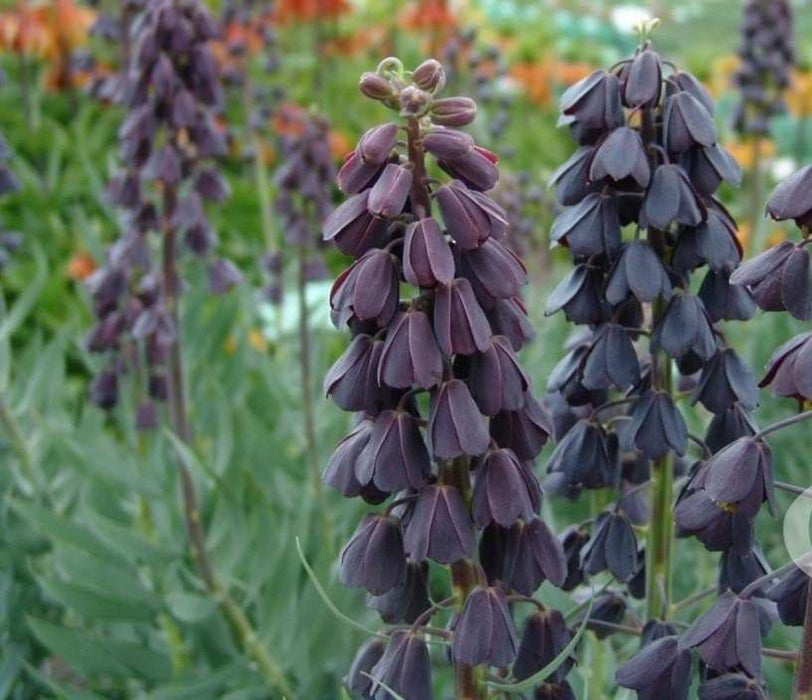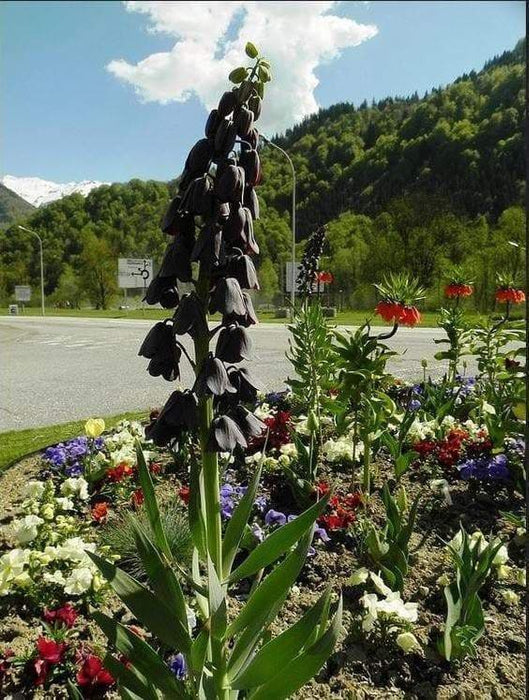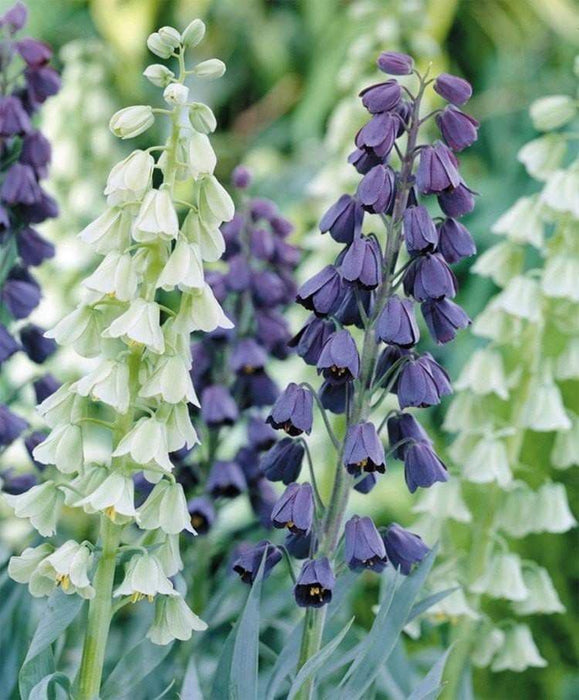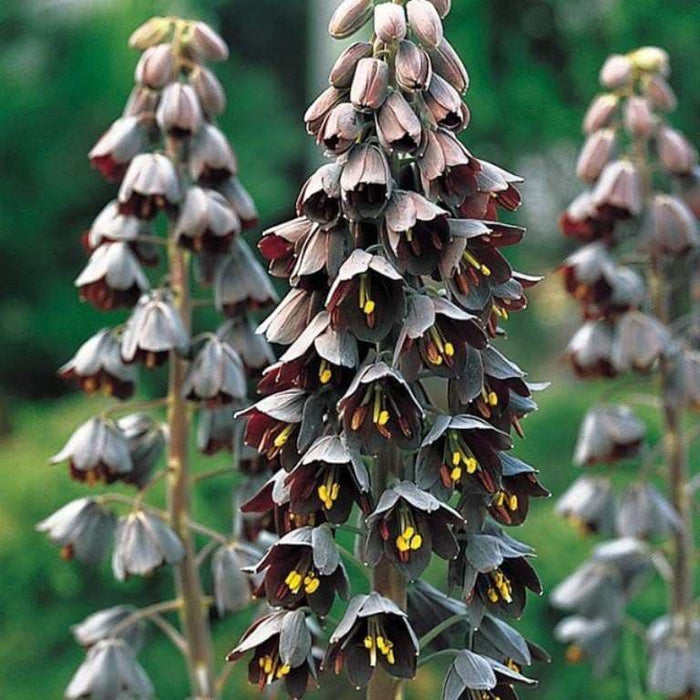
Fritillaria persica Flowers Seeds , Plum Bells ,
Original price
$ 6.09
-
Original price
$ 17.09
Original price
$ 6.09
$ 6.09
-
$ 17.09
Current price
$ 6.09
Most orders are processed by the next day
Select your desired size and/or color from the available options.
Fritillaria persica,One of most gorgeous looking Plant, Flowers Borders and Beds, Rock Garden or Wildflower Gardens
Fritillaria persica is a species of flowering plant of the genus Fritillaria in the family Liliaceae, native to southern Turkey, Iran, Iraq, Lebanon, Syria, Palestine and Israel. It is a robust bulbous perennial growing 30â60 cm tall.
The Fritillaria family has some of the worlds most gorgeous looking flowering plants and Fritillaria persica is no exception.
Fritillaria Persica Plum Bells
Detailed Description
Even well versed gardeners tend to be unfamiliar with this tall fritillaria, a cultivar that originates in southern Turkey, Cyprus and Syria. We believe persica plum bells should be more widely grown as it offers a tall form that is excellent placed at the back of the garden or along fences, and develops dozens of beautifully shaped plum to mahogany purple flowers encircling each stalk. The flower stalks are long lived, looking wonderful for several weeks. The foliage is attractive too, with a tendency to take on a bluish cast. Resistant to rodents and deer. Persica is endangered in the wild but be assured that all our bulbs are nursery grown.
SOWING ADVICE:
SOW SEEDS AT ANY TIME COVERING THEM WITH COMPOST OR GRIT 5MM DEEP, KEEPING THE SEED POT IN A COOL, WELL-LIT SPOT OUTDOORS. ARTIFICIAL HEAT IS NOT NEEDED AND PREVENT GERMINATION SO BE VERY PATIENT AS MANY SPECIES WILL ONLY GERMINATE IN THE SPRING AFTER CHILLING OR FREEZING IN THE MOIST SEED TRAY IN THE WINTER. GROW ON INDIVIDUAL SEEDLINGS IN SMALL POTS UNTIL OF SUFFICIENT SIZE TO BE POTTED ON OR PLANTED OUT INTO THE OPEN GROUND.
Sowing: Sow March to September or October to February.
Seeds need a period of cold to germinate. They can be left outdoors to go through the seasons naturally or germination hastened by âstratificationâ (imitating the seasons)
Sowing March to September.
Hastening germination by using stratification. Sow seed compost or something similar, place each container in a polythene bag and put into the refrigerator (not the freezer compartment) for 2-3 weeks.
After this time place the containers outside in a cold frame or plunge them up to the rims in a shady part of the garden border and cover with glass or clear plastic.
Some of the seeds may germinate during the spring and summer and these should be transplanted when large enough to handle. The remainder of the seeds may lay dormant until next spring. Germination is irregular often over several months. As each seed germinates transplant it almost immediately into its own pot.
Sowing October to February.
Sow the seeds compost, covering them with a thin layer of compost. After watering, place the seed container outside against a North wall or in a cold frame, making sure they are protected against mice, and leave them there until the spring.
The compost should be kept moist but not wet at all times, if the seed containers are out in the open then some shelter has to be given against excessive rain.
In the spring bring the seed containers into the greenhouse or indoors on to a well lit but not sunny windowsill and keep the compost moist. This should trigger off germination. If the seeds do not germinate in the spring keep them in cool moist conditions throughout the summer.
Prick out each seedling as it becomes large enough to handle, transplant into 7.5cm (3in) pots or trays to grow on. Plant out in spring into well drained soil. Gradually acclimatise to outdoor conditions for 10 to 15 days before planting out.
Cultivation:
Grows well in most fertile, humus-rich, well-drained soils and prefers cool, moist summers. Divide offsets, or collect and sow ârice-grainâ bulbils in late summer. Handle the fragile bulbs carefully and plant at four times own depth.
Plant Uses:
Cottage/Informal Garden, Flowers Borders and Beds, Rock Garden or Wildflower Gardens. Suitable for rock garden, raised bed or naturalising in grass
Materials: seed,flowers,FRITILLARIA RADDEANA Select your desired size and color from the available option
Fritillaria persica is a species of flowering plant of the genus Fritillaria in the family Liliaceae, native to southern Turkey, Iran, Iraq, Lebanon, Syria, Palestine and Israel. It is a robust bulbous perennial growing 30â60 cm tall.
The Fritillaria family has some of the worlds most gorgeous looking flowering plants and Fritillaria persica is no exception.
Fritillaria Persica Plum Bells
Detailed Description
Even well versed gardeners tend to be unfamiliar with this tall fritillaria, a cultivar that originates in southern Turkey, Cyprus and Syria. We believe persica plum bells should be more widely grown as it offers a tall form that is excellent placed at the back of the garden or along fences, and develops dozens of beautifully shaped plum to mahogany purple flowers encircling each stalk. The flower stalks are long lived, looking wonderful for several weeks. The foliage is attractive too, with a tendency to take on a bluish cast. Resistant to rodents and deer. Persica is endangered in the wild but be assured that all our bulbs are nursery grown.
SOWING ADVICE:
SOW SEEDS AT ANY TIME COVERING THEM WITH COMPOST OR GRIT 5MM DEEP, KEEPING THE SEED POT IN A COOL, WELL-LIT SPOT OUTDOORS. ARTIFICIAL HEAT IS NOT NEEDED AND PREVENT GERMINATION SO BE VERY PATIENT AS MANY SPECIES WILL ONLY GERMINATE IN THE SPRING AFTER CHILLING OR FREEZING IN THE MOIST SEED TRAY IN THE WINTER. GROW ON INDIVIDUAL SEEDLINGS IN SMALL POTS UNTIL OF SUFFICIENT SIZE TO BE POTTED ON OR PLANTED OUT INTO THE OPEN GROUND.
Sowing: Sow March to September or October to February.
Seeds need a period of cold to germinate. They can be left outdoors to go through the seasons naturally or germination hastened by âstratificationâ (imitating the seasons)
Sowing March to September.
Hastening germination by using stratification. Sow seed compost or something similar, place each container in a polythene bag and put into the refrigerator (not the freezer compartment) for 2-3 weeks.
After this time place the containers outside in a cold frame or plunge them up to the rims in a shady part of the garden border and cover with glass or clear plastic.
Some of the seeds may germinate during the spring and summer and these should be transplanted when large enough to handle. The remainder of the seeds may lay dormant until next spring. Germination is irregular often over several months. As each seed germinates transplant it almost immediately into its own pot.
Sowing October to February.
Sow the seeds compost, covering them with a thin layer of compost. After watering, place the seed container outside against a North wall or in a cold frame, making sure they are protected against mice, and leave them there until the spring.
The compost should be kept moist but not wet at all times, if the seed containers are out in the open then some shelter has to be given against excessive rain.
In the spring bring the seed containers into the greenhouse or indoors on to a well lit but not sunny windowsill and keep the compost moist. This should trigger off germination. If the seeds do not germinate in the spring keep them in cool moist conditions throughout the summer.
Prick out each seedling as it becomes large enough to handle, transplant into 7.5cm (3in) pots or trays to grow on. Plant out in spring into well drained soil. Gradually acclimatise to outdoor conditions for 10 to 15 days before planting out.
Cultivation:
Grows well in most fertile, humus-rich, well-drained soils and prefers cool, moist summers. Divide offsets, or collect and sow ârice-grainâ bulbils in late summer. Handle the fragile bulbs carefully and plant at four times own depth.
Plant Uses:
Cottage/Informal Garden, Flowers Borders and Beds, Rock Garden or Wildflower Gardens. Suitable for rock garden, raised bed or naturalising in grass
Materials: seed,flowers,FRITILLARIA RADDEANA Select your desired size and color from the available option
LET OUR CUSTOMER SPEAK FOR US

![[Seeds] - Caribbeangardenseed](http://caribbeangardenseed.com/cdn/shop/files/gift-card-gift-card-1_1024x1024_dfa857db-9150-4315-a362-7f0bb3fb9c47_60x28.png?v=1703978838)


